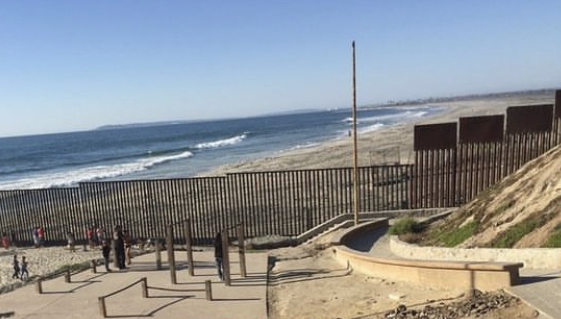Why are migrant drownings in Pacific Ocean at an all-time high?
SAN DIEGO – In the four years since the border wall height was increased from 17 feet to 30 feet along the US-Mexican border, drowning deaths of migrants in the Pacific Ocean off the coast of San Diego increased by 3,200 percent, according to a study published Thursday.
The report, published in the journal JAMA, was written by Dr. Anna Lussier, UC San Diego School of Medicine student, and Dr. Peter Lindholm, Gurnee Endowed Chair of Hyperbaric and Diving Medicine Research and professor in residence in the Department of Emergency Medicine at UCSD School of Medicine.
They hypothesized that the change in wall height may have resulted in an increase in marine and maritime migration attempts, resulting in more frequent drownings.

Photo shows a portion of the US-Mexico border wall separating San Diego from Tijuana, Mexico, where it meets the Pacific Ocean. Image: borderartists/IG
The study relied largely on publicly available data from the Missing Migrants Project – an initiative of the International Organization for Migration – which coordinates the UN network on migration and compiles data on migrants, refugees and asylum seekers who die during migration journeys, a statement from UCSD read.
Lussier and Lindholm analyzed data across two four-year periods: 2016- 2019, before the 30-foot wall was completed, and 2020-2023, after construction was finished. They compared deaths in areas where the wall is present against drowning rates in the Rio Grande, where the wall is largely absent.
According to the researchers, drowning in the San Diego region of the Pacific Ocean rose from 1 in the four years prior to the wall height change to 33 in the four years after, a net increase of 3,200%. In canals, that figure rose from 49 to 64 drownings, an increase of 30.6%, and in other bodies of water, from 15 to 35, an increase of 133.3%.
Along the Rio Grande, those numbers remained relatively stable across both periods, with 97 drownings prior to 2020, and 96 drownings after, for a net decrease of 1.03%.
“Looking at the numbers, you can see that it’s about the same in the Rio Grande, and it’s a little more but not extraordinarily more in the ditches and canals,” Lindholm said. “We don’t have absolute data on how many people migrated, but if the number of drownings was related to the rate of migration, you would probably have a similar increase at all places.”
According to Lussier, the idea for the report came about when she notice an information gap on migrant drowning deaths. She and Lindholm had been looking into the occupational health of people who work in the maritime environment in San Diego, such as lifeguards exposed to pollution and marine contamination.
“The lifeguards showed us a presentation on migrant rescues they were performing because of potential human smuggling,” said Lussier, who is also a doctoral student at UCSD Herbert Wertheim School of Public Health and Human Longevity Science. “Their stories weren’t showing up in the news, and the numbers struck me as odd.”
The data that did exist left major gaps, leading her and Lindholm to “compile a snapshot of migrant drowning deaths before and after the wall was augmented,” they write.
The researchers are working on a more fleshed-out view of their before- and-after picture, including how these migrants actually died, the UCSD statement read.
“Drowning is the endpoint of death in the water, but we’re trying to determine the actual cause of death: hypothermia? Hypoxia? Swimming-induced pulmonary edema?” Lindholm said.
Lussier says they want to expand their dataset to multiple regions and other factors that may be involved, such as weather and water temperature.
“Are more people drowning at a certain time of year, for instance?” she asked. “Can other sources give us information about the missing denominator of how many people tried migrating? Basically, we have this one data point, and now we want to understand what’s happening beyond this simple change in numbers.”
According to the authors of the paper, one of their end goals is to better understand medical outcomes among migrants who survive drowning, such as infections from contaminated water, lung injuries — even impacts on mental health.
“The scientists are also hoping to provide data that can inform decision making for policymakers and EMS systems, as well as those who provide medical care to migrants who survive marine migrations,” the statement reads. (CNS)

